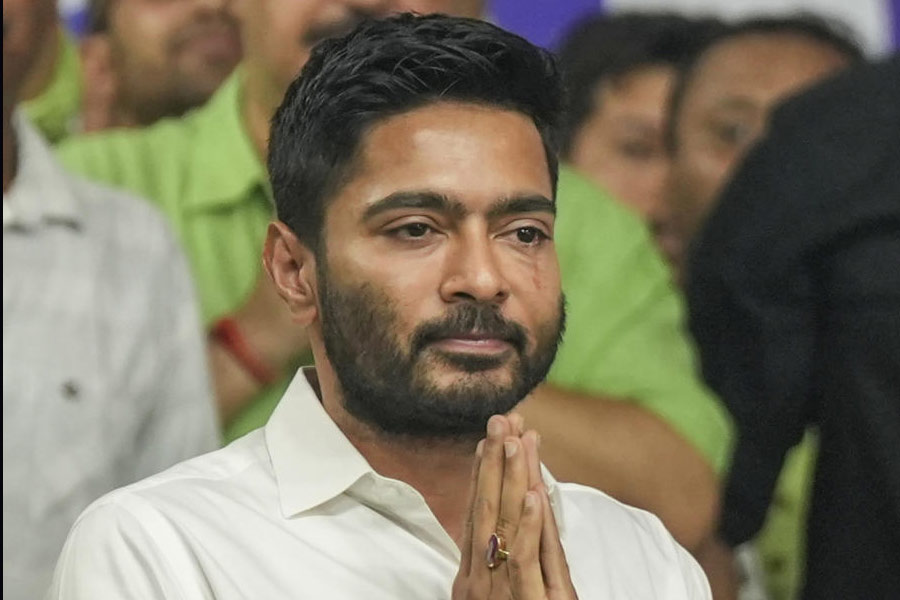 |
| Adoor Gopalakrishnan has moved away from the classical mould and now deals with more contemporary themes |
It was a poster that changed filmmaker Adoor Gopalakrishnan’s life. He was working with the government’s statistics department and travelling through Kerala when he spotted a signboard for the Film Institute of Pune. It was a moment that changed both his fate and that of Indian cinema.
But the master filmmaker was not born overnight. When he joined the film institute, it was initially to hone his skills as a playwright — he already had two plays under his belt. There, however, he discovered the best cinema directors from around the world and came in touch with Bengali filmmaker Ritwik Ghatak. The experience transformed his vision of what he wanted to do.
However, it took him a year to realise he couldn’t pursue cinema and theatre simultaneously. “I weaned myself away from theatre,” says Adoor. He’s now taking a breather with the premiere of his latest film, Naalu Pennungal (Four Women) at the Public Service Broadcasting Trust’s (PSBT) film fest in Delhi.
He says he is done with travelling abroad for the moment, having just returned from Israel, where he was guest of honour at the Cinema South Festival 2008 in Sederot. Three of his films, Nizhalkkuthu (Shadow Kill), Vidheyan (The Servile) and Dance of the Enchantress (a documentary), were showcased at the festival.
 |
 |
| A moment from Gopalakrishnan’s movie Mathilukal (Walls), which was inspired by Mohammad Basheer’s novella of the same name; (above) A still from Gopalakrishnan’s movie Naalu Pennungal (Four Women), which spins the tale of village women in mid-20th century Kerala |
“Immediately after a film is completed, I’m on tour. I don’t travel for travel’s sake. Yet in a way, I’m always on a holiday,” he smiles. You can believe that when he rattles off the places he will be zipping to in coming months — the lengthy list includes Brisbane, Jerusalem, Hamburg, Brussels and Athens.
The doyen of Malayalam cinema has in recent times been reading and re-reading short stories by late Malayalam novelist Thakazhi Sivasankara Pillai.
Four of these stories have been turned into Naalu Pennungal, which spins the tale of village women in mid-20th century Kerala. The titles —The Prostitute, The Virgin, The Housewife, and The Spinster — are basic but they get the point across. They are stories of women who live by the rules society has set for them. “When you watch the film, it’s about individual stories. Put them together and you see a progression in theme, time, conflict and levels of awareness,” notes Adoor.
The film had its world premiere in Toronto last September. It has since been shown to audiences in London, Nantes, Rotterdam, Goteborg, Manosque, Deauville, Miami, Seattle, Barcelona, Dubai and Goa.
The Spinster has actress Nandita Das playing an upper middle-class woman who must deal with being single. She confesses she did the film more for the experience of working with the director. Says Das: “His working style is such that not many people in the cast and crew know much about the script. I was the lucky one who at least knew what the story was and what my role was.”
PSBT’s managing trustee Rajiv Mehrotra, who has been associated with Adoor for some time — Adoor being the trust’s chairman — has been following his films closely. He points to Adoor’s masterly control over his craft. “There’s this sequence in Four Women of people sitting and eating in complete silence. It’s a powerful moment that reveals his courage to deal with silence,” says Mehrotra.
Adoor is still on the short story trail. His next film Oru Pennum, Randu Annum (A Woman, Two Men) which is almost ready for release is also based on a Thakazi story. “A short story is always sharp. It allows me the scope to introduce new characters and new resolutions,” says Adoor.
And though he doesn’t much like adaptations, he has allowed himself to be influenced by Vaikkom Mohammad Basheer’s novella Mathilukal (Walls) in his film by the same name and Paul Zacharia’s long story for Vidheyan.
“Inspiration can come from anywhere. In 1992, I came across a small item in a newspaper about the last hangman in India. It captured my fancy and I worked on it for over 10 years researching till Nizhalkkuthu saw the light of day some time in 2002,” he says, talking about the film that has travelled to 15 festivals around the world including ones at Toronto, London, Rotterdam and Rome.
 |
| A scene from the film Vidheyan (The Servile), which was showcased at the Cinema South Festival 2008 in Sederot in Israel |
It’s ironic that his niche audience is international. His films are nationally distributed in France but they hardly travel within India. Says Adoor: “The audiences are there. But we’ve failed unpardonably in taking the films to the audience. What is needed is a distributor with an understanding of international cinema. Most of them tend to run after big star names.”
There’s also another irony to his life, he points out. “I never thought I would be associated with cinema in any way,” he says. Theatre was his first love from the age of eight. He recounts memories of weekend meetings of a group of three boys — Ravindran, Narayanan and Gopalakrishnan — at a cashew grove. They enacted plays there, and called themselves the RNG Company.
His interest in theatre wasn’t surprising. His family had patronised Kathakali for generations and they even had their own Kaliyogam or Kathakali troupe. “Plus I had the opportunity to watch films for free,” says Adoor. His uncle owned theatres at towns like Adoor, Enath and Parakkode. However it was only at the Film Institute in Pune that he was inspired by moviemakers like Satyajit Ray, Mrinal Sen and Ghatak.
Since then he has lived and breathed cinema. In Kerala, he pioneered a wave of new cinema culture by founding Chitralekha, Kerala’s first Film Co-operative Society for film production, in 1965. His aim, he says, was to keep his audiences abreast with world films.
The corners of Adoor’s mouth crinkle into a cheery smile that grows wider when asked about his lack of interest in Bollywood. Recently he watched a Hindi film (for 10 minutes) — he doesn’t want to reveal the name. “I couldn’t sit through it. There’s so much of money in the industry that directors don’t know how to use it except for splashing out on ridiculous film sets,” he laughs.
 |
| Gopalakrishnan receiving the Dadasaheb Phalke award for the year 2004 from former President Dr APJ Abdul Kalam |
“On a serious note, I wouldn’t be able to make a film in Hindi because I don’t know the nuances.” If he makes films only in Malayalam, he points out, it’s because it’s part of the culture in which he was raised.
Fittingly, says film critic C.S. Venkateswaran who has also edited a book on the moviemaker called A Door to Adoor, his films map the subterranean history of his home state. “Adoor brought in a new wave of cinema in Kerala. For instance his second film Kodiyettam (Ascent), released in 1977, is an intimate experience of everyday rural life. The protagonist Shankaran Kutty’s growth from childhood to adulthood draws parallels to the social and historical changes in Kerala,” says Venkateswaran.
Adoor’s films, needless to say, do not revolve around singing and dancing or even predictably ‘good looking boys and girls’. But the label ‘art filmmaker’, or even ‘serious filmmaker’ does not sit easy on his shoulders. He simply states: “What is parallel cinema really? I am what I’ve done. I just make cinema. My films make my audience experience life at its core level with no inherent superficiality.”
Mehrotra, who has watched Adoor in action, says just like Ray he seeks to go “intensely local” with his themes and universalise his message. He adds that the “inheritances of Kathakali have had a profound impact on his work. It’s the juxtaposition of the grand gestures as opposed to the subtle twitches and gestures in the dance form that also comes through in his films. It’s diminishing a bit now. It goes to his credit that he has adapted himself from the classical mould to more contemporary themes like what he dealt with in Four Women.”
His debut film, the national award winning Swayamvaram (One’s Own Choice), in 1972 is considered a milestone in Malayalam film history. It went to film festivals in Moscow, Melbourne, Lon don and Paris. He followed it up with films like Kodiyettam (Ascent), Elippathayam (Rat Trap), Mukhamukham (Face to Face), Anantharam (Monologue), Mathilukal (Walls), Vidheyan (The Servile), Kathapurushan (The Protagonist), Nizhalkkuthu (Shadow Kill) — all of which were screened at international film fests and won him numerous national and international awards.
In between films — Adoor always took a gap of a few years to release each of them — he worked on some 30 documentaries including one on Kathakali exponent Kalamandalam Gopi.
While delving into the world of cinema and documentaries, he’s also been a jury member at international film festivals. The list is as long as the awards he has received — the most significant being the Dadasaheb Phalke Award, India’s highest national honour for lifetime achievement in cinema, the Padma Vibhushan for his contribution to the arts and the title of ‘The Commander of the Order of Arts and Letters’ from the French Government in recognition of his contribution to international cinema.
His achievements roll on. He authored a book, Cinimayude Lokam (The World of Cinema) that won him a National Award. He has also penned two plays and a book on plays and playwrights. So many awards and accolades have given Adoor a quiet confidence. “People think I’m modest. I’m not. I know very well what I want from life,” he says. “Sometimes it has even made my wife say that I am a difficult person to live with,” he smiles. “I hope she’s not in earnest.”
Adoor with his no-frills style of filmmaking is a perfectionist to the core. Cameraman Sunny Joseph who assisted him on the sets of Nizalkkuthu describes him as meticulous. “He’s hands-on in every department and very precise about what he wants. On a limited budget, you can’t afford to be otherwise,” says Joseph.
The man — who in 35 years of filmmaking has come up with just 10 movies — takes his time in coming out with a film. According to Mehrotra, a distinguishing thing about the filmmaker that he has the “courage to do nothing after a film is completed, till the next film grows and emerges within him”.
Concentrating on one project at a time, Adoor graphs out each part of it. He confesses: “There’s very little that surprises me because I spend great time planning and executing the most minute detail.” Which is why when the lights dim in the theatre, Adoor Gopalakrishnan will once again have the audiences spellbound.











